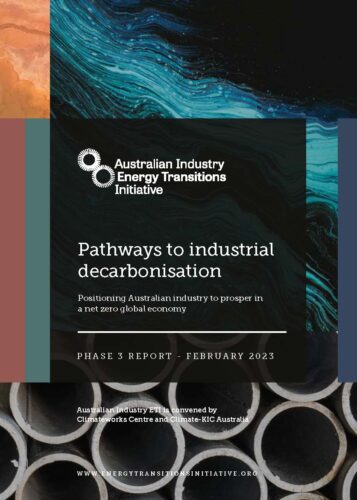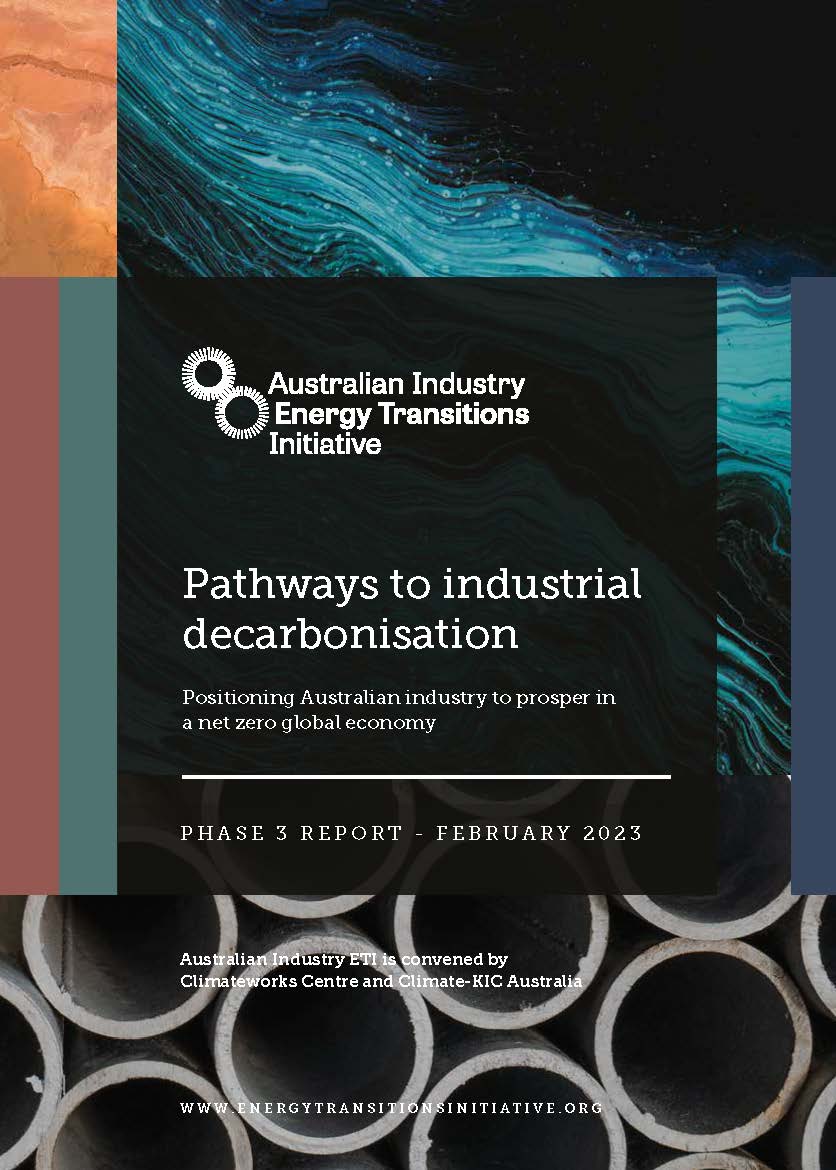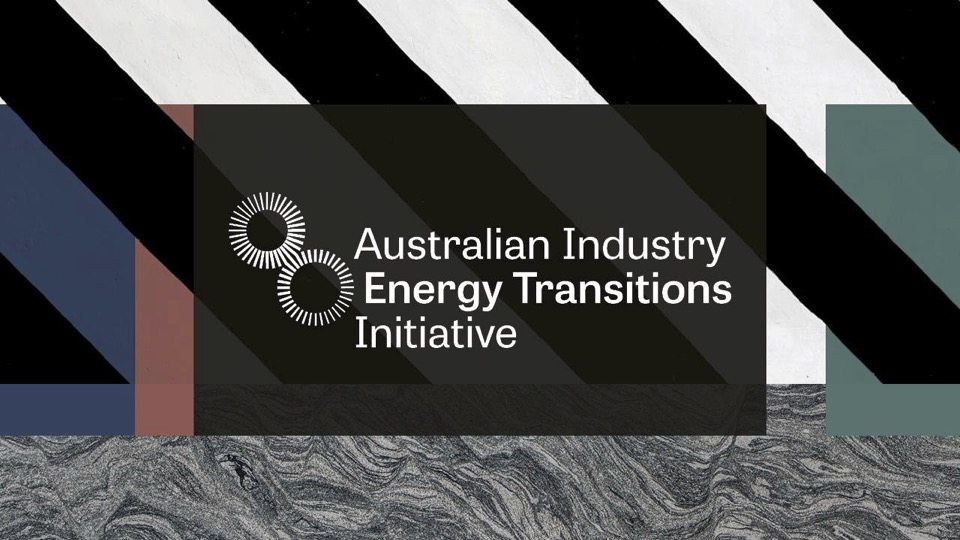20 February 2022, Sydney – A new report has, for the first time in Australia, outlined decarbonisation pathways that show it is possible for five of Australia’s most significant heavy industry supply chains to transition to net zero, consistent with global efforts to limit warming to 1.5ºC.
Done in collaboration with companies representing around a fifth of Australia’s industrial emissions and a third of the ASX100 market value, the report finds strong, effective and coordinated action from government, industry and finance is crucial for the net zero transition.
Launching today in Sydney, at an event with The Hon Chris Bowen MP, Minister for Climate Change and Energy, and Lord Adair Turner (who has been an advisor to the project through the UK-based Energy Transitions Commission), the report is the third and final of the Australian Industry Energy Transitions Initiative (Australian Industry ETI).
It identifies five objectives to enable heavy industry to transition to net zero emissions consistent with global efforts to limit warming to 1.5ºC. They are for Australia to:
- Set a strong, clear, enduring framework with a net zero emissions goal to align industry, finance and government
- Transition to the large-scale, cost-competitive, renewable energy system of the future
- Accelerate development and demonstration of the emerging technologies needed
- Drive deployment of low-carbon solutions, reduce barriers and support investment towards the transition
- Develop integrated net zero emissions industrial regions, supply chains and energy network solutions.
‘Commitment from industry to the long-term transition is a positive step towards developing the capabilities needed, avoiding the risk of stranded assets and higher long-term energy costs, and for ensuring a future in which Australian energy-intensive industries are competitive in a decarbonised world,’ said Australian Industry ETI Chair, Simon McKeon AO, Chancellor of Monash University, former CSIRO Chairman and former Australian of the Year.
‘With strong ambition, coordinated action and government support, industry emissions could be reduced by up to 92 per cent by 2050, based on 2020 levels. This, with high quality and verifiable offsets for the remaining 8 per cent, would transition industry to net zero emissions in support of the ambition to limit warming to 1.5ºC.
‘This is a moment of opportunity to align and focus efforts to create a globally competitive, equitable, net zero emissions industrial economy in Australia. Action is needed now to lay the foundations, capitalise on the opportunities, and avoid more costly emissions reduction measures in the future,’ he said.
The report outlines how over 1.3 million jobs could be created between 2025 and 2050 in the ambitious 1.5°C scenario. Investment by government, industry and investors could support up to 64,000 construction jobs per year from 2025 to 2050, plus an additional 129,000 roles in operations and maintenance between 2025 and 2050.
 The ‘Pathways to industrial decarbonisation’ report is the result of a three-year collaboration between some of Australia’s largest companies, as part of the Australian Industry ETI convened by not-for-profits Climateworks Centre and Climate-KIC Australia. The report was prepared for the Australian Industry ETI by Climateworks and CSIRO, in consultation with industry and research partners.
The ‘Pathways to industrial decarbonisation’ report is the result of a three-year collaboration between some of Australia’s largest companies, as part of the Australian Industry ETI convened by not-for-profits Climateworks Centre and Climate-KIC Australia. The report was prepared for the Australian Industry ETI by Climateworks and CSIRO, in consultation with industry and research partners.
‘This three-year program has shown that transitioning heavy industries in a carbon intensive economy, like Australia’s, is a challenge that will require a transformational shift in the energy system,’ said Anna Skarbek, CEO, Climateworks Centre, which is based at Monash University. ‘This includes accelerated action on technology and investment, especially in targeted place-based approaches focused on common net zero goals.’
‘The transition is an investment in modernising Australia’s industrial regions and energy system that, over a 30-year period, equates to roughly A$20.8 billion per year if Australia is to remain on track to limit warming to 1.5ºC. Around two thirds of this investment is in the energy system and one third in industry technologies, electrification and energy efficiency.
‘To put this into context, it represents a tenth of the export value of the five supply chains in focus for the Australian Industry ETI – approximately A$236 billion each year – and is comparable to investments made through other major efforts,’ said Anna Skarbek.
The report finds that renewable energy is a critical enabler of industrial decarbonisation to be scaled up rapidly, and that industry’s early uptake and effective integration of renewable electricity, electrification, and use of green hydrogen to substitute for other fuel sources can help Australia achieve competitive costs for reliable decarbonised energy.
‘Achieving these pathways needs at least a doubling of total current electricity generation by 2050, but this is possible through multi-gigawatt renewable generation developments some of which are already in advanced stages of planning,’ said Paul Graham, CSIRO’s Chief Energy Economist and report contributor.
‘Having the Minister and Lord Adair Turner speak with Australian Industry ETI participants at the launch of this report today is significant. Collaboration has been a hallmark of the three-year initiative, and it is only by working together – with government, industry, civil society, researchers and financial sector – that we will see the sort of systems transformation needed to deliver on our emissions reductions targets,’ said Chris Lee, CEO of Climate-KIC Australia.
ABOUT THE INITIATIVE
The Australian Industry Energy Transitions Initiative is a platform for Australia’s emissions-intensive industry and related businesses to coordinate learning and action on net zero emissions supply chains.
The Australian Industry ETI drew together 18 industry partners that represent approximately 22 per cent of Australia’s industrial emissions and approximately 32 per cent of the market value of the ASX100. They include Australian Gas Infrastructure Group, APA Group, Aurecon, AustralianSuper, BHP, BlueScope Steel, bp Australia, Cbus, the Clean Energy Finance Corporation, Fortescue Metals Group, HSBC, Orica, National Australia Bank, Rio Tinto, Schneider Electric, Wesfarmers Chemicals, Energy & Fertilisers, Westpac and Woodside Energy.
The pioneering initiative convened Australian industry and business leaders to collectively explore and address the challenges associated with decarbonisation and is chaired by Simon McKeon AO, Chancellor of Monash University, former CSIRO Chairman and former Australian of the Year.
The Australian Industry ETI supported Australian heavy industry to realise the opportunities of a decarbonised global economy by working collaboratively to develop pathways and actions towards achieving net zero emissions in critical supply chains by 2050.
The Australian Industry ETI focused on five supply chains that collectively contribute more than one quarter of Australia’s annual greenhouse gas emissions and generate significant exports. The five supply chains include steel, aluminium, other metals (such as lithium, copper and nickel), chemicals (such as explosives and fertiliser) and liquified natural gas.
Decarbonisation pathways for Australia’s industrial supply chains were developed with the ambition of achieving emissions reductions in line with limiting global warming to 1.5°C. Independent not-for-profits Climateworks Centre (operating within Monash University) and Climate-KIC Australia co-convened the Australian Industry ETI in collaboration with the Energy Transitions Commission.
The Australian Industry ETI was developed with the generous support of philanthropic donations, contributions from participant organisations and funding from the Australian Government through the Australian Renewable Energy Agency. It is supported by the Australian Industry Group and the Australian Industry Greenhouse Network, with research partners including BloombergNEF, CSIRO and RMI.
The Australian Industry ETI considered opportunities across the Australian economy, with some work specifically focused on Western Australia as a high-opportunity state.
Pathways to industrial decarbonisation: Positioning Australian industry to prosper in a net zero global economy and supporting reports will be published on 20 February 2023 and available online here.
Media enquiries:
David Imber, Mountain Media, 0413 274 204 or david@mountainmedia.com.au
Quotes attributable to Australian Industry ETI participants
Innes Willox, Chief Executive, Ai Group
‘The pathways for thriving Australian industries in a net zero emissions world are clearer today thanks to this initiative. Getting there requires at least two big things from policy makers. First, we need to manage dramatic change and expansion in our energy systems, with all the growing pains that involves. Building things has been getting harder, but Australia’s economy and climate depend on making major new projects happen across the country. Secondly, policy needs to provide a basis for industry to invest in deep decarbonisation without losing competitiveness. The redesign of the Safeguard Mechanism will not be complete until there is a long-term measure to avert carbon leakage.’
Liz McNamara, Group Executive, Sustainability & Corporate Affairs, APA:
‘We welcome the release of the Australian Industry Energy Transitions Initiative final report and thank the initiative’s industry partners, conveners and chair for their contributions.
‘Our Climate Transition Plan embeds APA’s pathway to achieve our net zero goal and is an important next step in our commitment to actively participate and support Australia’s energy transition, consistent with the objectives of the Paris Agreement.
‘As the ETI report points out, decarbonising heavy industry will require significant investment of more than $20 billion each year. It is imperative that all stakeholders work together to ensure this doesn’t affect the affordability of energy for households and businesses.
‘The final ETI report highlights the enormous investment opportunity the energy transition presents. While the economics and science of developing a clean hydrogen economy continues to evolve, the report demonstrates the importance of achieving this and APA’s Pathfinder program is actively supporting opportunities in this space.’
Paul Gleeson, Aurecon Group Director – Sustainability and Managing Director, Energy – Australia & New Zealand:
‘The report findings are an exciting step forward and demonstrate a pathway to retain and even grow Australia’s industrial activity.
‘These findings demonstrate that it is possible for Australia to continue to be a global industrial and energy superpower but we all must be prepared to do the heavy lifting together to navigate the ambitious implementation timeline.
‘Leadership from industry alone is not enough. We’ve seen first-hand progress that represents strong action on climate including early-stage investments in industrial-scale green steelmaking, green ammonia and the decarbonisation of the aluminium supply chain. But these investments and effort need to be coordinated so that whole regions are evolving and positioning themselves for long term success in a decarbonised future.’
Andrew Gray, Head of ESG & Stewardship, AustralianSuper:
‘The Australian Industry ETI’s latest report outlines the pathways necessary to decarbonise five of the heaviest industry sectors in Australia, providing a unique industry and investor perspective on the barriers and opportunities. It demonstrates how by working together, industry, investors and government can help solve these decarbonisation challenges to benefit the Australian economy, workforce and superannuation fund members. This work is a critical part of transitioning the Australian economy and our investment portfolio to net zero emissions by 2050.’
Frédéric Baudry, President, bp Australia and SVP fuels & low carbon solutions, Asia Pacific:
‘The ETI report demonstrates that it is possible to decarbonise our economy even in the most hard-to-abate sectors. It also tells us that to make the energy transition happen, there is no time to waste; we need to get on with the investments and construction required. bp is ready to invest in the energy transition to help provide affordable, reliable and sustainable energy for Australia’s future.’
Kobad Bhavnagri, Global Head of Strategy, BloombergNEF:
‘Industrial decarbonisation is both an economic imperative and a huge opportunity for Australia. This work shows that modernising Australia’s industry for the renewable age will generate millions of jobs, billions of dollars of investment and a lucrative new suite of export opportunities. Industrial transformation will be both an enabler and beneficiary of Australia’s transition to a renewable energy superpower.’
Kristian Fok, Chief Investment Officer, Cbus Super:
‘The ETI’s third and final report is a prime example of effective industry collaboration – identifying implementable actions to address and assist heavy industry decarbonise through the transition. The report supports an orderly transition, creates investment and job creation opportunities – initiatives vitally important for the economy and our members’ returns.’
Ian Learmonth, CEO, Clean Energy Finance Corporation:
‘This report is an important development in the approach to how we think about emissions and industry. While it’s clear there are unique challenges to transition to a greener industrial sector, it is also clear that Australian industry can and should play a central role in our low emissions future. Stronger, cleaner manufacturing capitalising on the benefits of the clean energy transition offers exciting potential for our economy as well as our emissions profile.’
Adair Turner, Chair, Energy Transitions Commission:
‘Australia’s economic future in a net-zero world is hugely positive and prosperous. Blessed with abundant natural wind and solar resources it can both decarbonise its own economy rapidly and become a major exporter of green hydrogen to countries across the world. Seizing this opportunity will require collaboration from government, industry, finance and communities working together to accelerate the energy transition and turn ambition into real-world economic advantage.’
Jacqueline Fox, Chief Climate Officer, NAB:
‘Australia is at a critical juncture in its transition to a low-carbon economy. If we get it right, the opportunities are immense in protecting our environment from the effects of climate change, and in growing our economy.
‘This report shows, with the right economic and policy support, viable pathways exist to dramatically decarbonise Australia’s heavy industries, and supports our view that investments made today will reduce the cost of the transition over the long run and deliver real economic upside for Australia.
‘This is particularly important for our customers in heavy industry, where emissions are hard to abate and solutions are not yet economically feasible or are still in early stages of development. This is a formidable challenge that will require business, governments and the broader community working together and taking action.
‘NAB is supporting our customers to decarbonise and build financial resilience. We will fund the investments needed to create a strong and sustainable future for Australia.’
Sanjeev Gandhi, Managing Director and Chief Executive Officer, Orica:
‘As a foundation member of this initiative, we’re encouraged by the findings of the report and the pathways established to decarbonise some of Australia’s hardest to abate sectors. Decarbonising industrial and heavy industries is difficult and expensive and will require continued collaboration and coordinated action between industry and government.
‘Orica is committed to acting now to decarbonise its own operations and support our customers and suppliers in achieving their abatement goals. We are already working closely with industry and government to deploy low-emissions technology such as tertiary catalyst abatement at our operations in Canada and Australia. We are confident that together we can create a more sustainable future for our operations and the regions we operate in, ensuring Australia remains competitive and attractive as a manufacturing base as the world transitions to a lower-carbon economy.
‘Orica also has a critical role to play in the future of lower-carbon manufacturing hubs across the Hunter Valley and Gladstone regions. We are well-positioned to leverage our existing manufacturing assets, technologies, and proximity to supply networks to accelerate the development of these hubs, creating jobs and integrated, sustainable industrial regions of the future.’
Kellie Parker, Chief Executive, Australia Rio Tinto:
‘The ‘Pathways to industrial decarbonisation’ report further highlights the scale and complexity of the decarbonisation challenge ahead for Australia’s industrial sector. Rio Tinto is committed to net zero scope 1 and 2 emissions by 2050 but, like our industry peers, we face a series of significant and interconnected challenges. While these should not be underestimated, the report highlights that with coordinated action, investment support, and strong partnerships, we can ensure Australia is well-positioned to become a net zero industrial economy.’
Pacific Zone President, Schneider Electric, Gareth O’Reilly:
‘Energy transition is inevitable for all businesses, yet most organisations have much work to do to reach net zero, reducing their impact on climate change directly and via their supply chain and end users. Leaders need to move fast – they need to invest in digitising energy management to firstly understand the scope of the challenge ahead and then identify the means to achieve sustainability targets. It’s ‘make or break’ time for businesses to address energy transition. We need a rapid rollout and sustainability skills are a leading determinant of progress.’
Ian Hansen, Managing Director, WesCEF:
‘WesCEF has a longstanding presence in Western Australia’s major industrial area where a strong legacy of collaboration across industries already exists.
‘As an emissions-intensive industrial region, collectively pursuing decarbonisation opportunities is a natural next step, and WesCEF is proud to be working currently with several industry partners on exciting projects to help deliver our targeted abatement.’
Anthony Miller Chief Executive, Westpac Institutional Bank:
‘Industry, government and the broader community have a shared net-zero ambition for our nation. We need to work together across all levels of the economy and community to ensure a swift, but just transition. This will only be achieved through partnership and sharing common goals.’
Tony Cudmore, Executive Vice President, Strategy and Climate, Woodside:
‘Woodside is pleased to receive this report. It contributes to research about Australia’s potential emissions reduction pathways, and makes recommendations about the need for strong, effective, coordinated action from government, industry and finance. These recommendations deserve careful consideration.’








